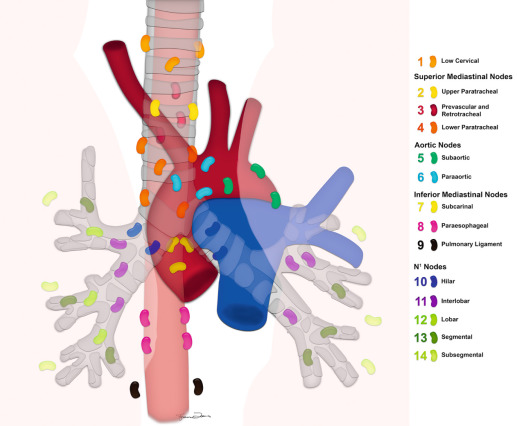Physical Address
304 North Cardinal St.
Dorchester Center, MA 02124
A standardized staging system is fundamental in delivering evidence-based treatment tailored to an individual patient. To determine the extent of a tumor and choose treatment strategies, an accurate staging system is essential. The stage of the tumor is the single most important factor in determining prognosis in patients with lung cancer. The American Joint Committee on Cancer (AJCC) and Union for International Cancer Control (UICC) are two international bodies that define and unify lung cancer staging classification. Periodic revisions of the staging system are required to include innovations in diagnostic methods and management strategies and are proposed by the Working Committee from the International Association for the Study of Lung Cancer (IASLC). The staging system most commonly used is the TNM classification, in which T refers to features of the primary tumor, N indicates metastasis to regional lymph nodes, and M describes the presence or absence of distal metastasis. The latest 8th edition of the TNM classification of malignant lung tumors took effect on January 2017 ( Table 24.1 ).
| Descriptor | Category | Definition |
|---|---|---|
| Tumor (T) | Tx | Primary tumor cannot be assessed or cytologically proven primary tumor that is not visualized by imaging or bronchoscopy |
| T0 | No primary tumor | |
| Tis | Carcinoma in situ | |
| T1 | Tumor <3 cm in greatest dimension | |
| T1a | Tumor <1 cm Minimally invasive adenocarcinoma Superficially spreading tumor of any size confined to bronchial or tracheal wall |
|
| T1b | Tumor >1 cm but <2 cm | |
| T1c | Tumor >2 cm but <3 cm | |
| T2 | Tumor >3 cm but <5 cm in greatest dimension or tumor <5 cm that is associated with:
|
|
| T2a | Tumor >3 cm but <4 cm | |
| T2b | Tumor >4 cm but <5 cm | |
| T3 | Tumor >5 cm but <7 cm in greatest dimension or tumor <7 cm that is associated with:
|
|
| T4 | Tumor >7 cm in greatest dimension or tumor of any size that is associated with:
|
|
| Node (N) | Nx | Regional lymph nodes cannot be assessed |
| N0 | No regional lymph node involvement | |
| N1 | Involvement of ipsilateral intrapulmonary and peribronchial or ipsilateral hilar lymph nodes | |
| N2 | Involvement of ipsilateral mediastinal lymph nodes or subcarinal lymph nodes | |
| N3 | Involvement of contralateral mediastinal or hilar lymph nodes or supraclavicular lymph nodes | |
| Metastasis (M) | M0 | No distant metastasis |
| M1 | Distant metastasis | |
| M1a | Malignant pleural effusion/nodules a or malignant pericardial effusion/nodules a or separate nodules in contralateral lung | |
| M1b | Single extrathoracic metastasis | |
| M1c | >1 extrathoracic metastases |
a Most pleural and pericardial effusions in patients with lung cancer are caused by tumor. However, if multiple fluid analyses are negative for tumor cells, if fluid is not bloody, if fluid is not an exudate, and if clinical impression is concordant, then the effusion should not be considered in staging classification.
The most common imaging modalities used for clinical staging of lung cancer are computed tomography (CT), magnetic resonance (MR), and positron emission tomography (PET). Given the fact that each of the modalities has pitfalls, these often need to be used in combination or be complemented by an additional surgical procedure to determine the correct tumor stage. The pitfalls apply particularly while assessing the N component of the TNM classification because the metastatic involvement of regional lymph nodes may be difficult to detect reliably by imaging alone. Combined CT/PET currently has the highest accuracy for nodal disease among imaging modalities and commonly is used not only to guide the management but also in the selection of the best approach for surgical staging if required. CT/PET has been shown to have high negative predictive value, particularly in the context of stage I or II lung cancers. Its specificity, however, is limited because many nonneoplastic processes may result in a false-positive scan. Therefore, mediastinal lymph nodes that are judged to be positive on PET/CT scan usually require histologic confirmation for accurate staging. The mediastinal and hilar lymph nodes are separated into 14 nodal levels ( Fig. 24.1 ). Nodes numbered 1 to 9 are in the mediastinum, and nodes numbered 10 to 14 are in the hilum and lung. The left brachiocephalic vein and aortic arch divide the upper and lower paratracheal nodes (nodes 2R, L, and 4R, L)
| Imaging | Bronchoscopic or Endoscopic | Surgical |
|---|---|---|
| CT | Rigid bronchoscope | Mediastinoscopy |
| MRI | Flexible (fiberoptic bronchoscope) | Anterior mediastinotomy |
| PET | Navigational bronchoscope | VATS |
| Combined PET/CT | EBUS | |
| Combined PET/MR | EUS |

Become a Clinical Tree membership for Full access and enjoy Unlimited articles
If you are a member. Log in here